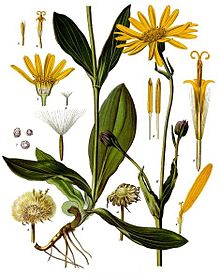Arnica is a genus of perennial, herbaceous plants in the sunflower family (Asteraceae). The genus name Arnica may be derived from the Greek arni, “lamb”, in reference to the plants’ soft, hairy leaves. Arnica is also known by the names Mountain Tobacco and, confusingly, Leopard’s bane and Wolfsbane—two names that it shares with the entirely unrelated genus Aconitum.
Arnica plants have a deep-rooted, erect stem that is usually unbranched. Their downy opposite leaves are borne towards the apex of the stem. The ovoid, leathery basal leaves are arranged in a rosette.
They show large yellow or orange flowers, 6–8 cm wide with 10–15 cm long ray florets and numerous disc florets. The phyllaries (a bract under the flowerhead) has long spreading hairs. Each phyllary is associated with a ray floret. Species of Arnica, with an involucre (a circle of bracts arranged surrounding the flower head) arranged in two rows, have only their outer phyllaries associated with ray florets. The flowers have a slight aromatic smell. If taken in the wrong dose it can be very dangerous.
The seedlike fruit has a pappus of plumose, white or pale tan bristles. The entire plant has a strong and distinct pine-sage odor when the leaves of mature plants are rubbed or bruised.
Commercial Arnica preparations are frequently used by professional athletes. According to The Memorial Sloan-Kettering Cancer Center, “A few clinical trials suggest benefits of topical arnica for osteoarthritis; and for affecting significant reduction of bruising compared to placebo or low concentration vitamin K ointments. However, a small study reported that topical arnica actually increased pain 24 hours after calf exercises.
Arnica Uses
Early studies of topical arnica gels and ointments for arthritis symptoms of the hand and knee — like pain and swelling — have been positive. So far, research is mixed on whether arnica skin treatments can help ease muscle pain.
If eaten, the actual herb is toxic and can be fatal. However, some oralsupplements contain highly diluted arnica. These are considered homeopathic treatments. These low-dose arnica tablets are safe to use and have been studied for muscle pain, diabetic eye damage, and swelling and pain after surgery. More research needs to be done to establish effectiveness for those problems. A study of children with cancer, however, found that homeopathic low-dose arnica may help reduce mouth ulcers related to chemotherapy.
Because of the risks of pure arnica, the FDA classifies it as an unsafe herb. Doctors who practice complementary medicine generally advise against using arnica in any form other than in a highly diluted homeopathic form.
How to Take Arnica ? What Should I know before I take Arnica ?
Arnica is a plant-based remedy most commonly used in homeopathic and herbal medicine to help with pain, swelling, bruising, and muscle soreness. It comes from the Arnica montana plant, a flowering herb in the daisy family, native to Europe and North America.
✅ What Is Arnica Used For?
- Muscle soreness and stiffness
- Bruising and swelling (e.g. after injury or surgery)
- Arthritis-related joint pain
- Insect bites (topical use)
- Minor sprains or strains
💊 How to Take Arnica
There are two main forms of Arnica:
1. Topical Arnica (Creams, Gels, Ointments)
- Application: Apply a thin layer to the skin where pain, bruising, or inflammation occurs.
- Frequency: Usually 2–3 times a day.
- Important: Never apply to broken or irritated skin.
2. Oral Arnica (Homeopathic Pellets/Tablets)
- Dosage: Follow label instructions or a homeopathic practitioner’s guidance.
- Potency: Often marked as 30C, 200C, etc. (Homeopathic dilutions).
- Administration: Place pellets under the tongue; do not handle directly with fingers.
- Note: These preparations are highly diluted and are not the same as herbal extracts.
⚠️ What Should I Know Before Taking Arnica?
❗ Cautions:
- Toxic in raw form: Never ingest raw arnica or concentrated extracts – they can be poisonous.
- Only homeopathic forms are safe to take orally.
- Avoid during pregnancy or breastfeeding unless under professional guidance.
- Avoid use on open wounds or near the eyes/mouth (topical forms).
🚫 Possible Side Effects:
- Skin irritation or rash (topical)
- Allergic reaction (especially if sensitive to plants like daisies, marigolds, or ragweed)
- Nausea, dizziness, or heart irregularities (from improper oral use)
🩺 Interactions:
- Blood thinners: May increase bleeding risk
- Anti-inflammatory drugs: May have additive effects
- Always consult a healthcare provider if you’re on medications or have chronic conditions.
Would you like a recommendation on when to use Arnica for recovery or pain management?

